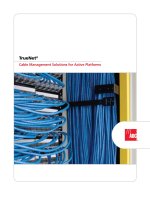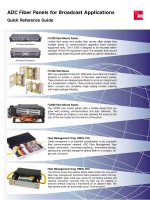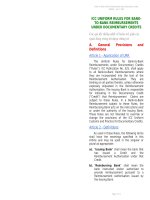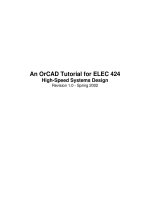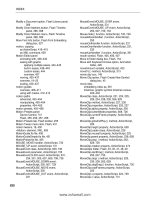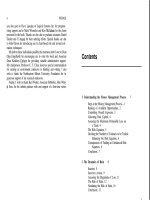Tài liệu Money Management Strategies For Serious Traders(pdf) pptx
Bạn đang xem bản rút gọn của tài liệu. Xem và tải ngay bản đầy đủ của tài liệu tại đây (8.8 MB, 46 trang )
M
M
o
o
n
n
e
e
y
y
M
M
a
a
n
n
a
a
g
g
e
e
m
m
e
e
n
n
t
t
S
S
t
t
r
r
a
a
t
t
e
e
g
g
i
i
e
e
s
s
f
f
o
o
r
r
S
S
e
e
r
r
i
i
o
o
u
u
s
s
T
T
r
r
a
a
d
d
e
e
r
r
s
s
P
P
R
R
E
E
S
S
E
E
N
N
T
T
E
E
D
D
B
B
Y
Y
D
D
A
A
V
V
I
I
D
D
C
C
.
.
S
S
T
T
E
E
N
N
D
D
A
A
H
H
L
L
T
T
h
h
e
e
I
I
m
m
p
p
o
o
r
r
t
t
a
a
n
n
c
c
e
e
o
o
f
f
M
M
o
o
n
n
e
e
y
y
M
M
a
a
n
n
a
a
g
g
e
e
m
m
e
e
n
n
t
t
Traders can typically describe the methods they use to initiate and liquidate trades. However,
when forced to describe a methodology for the amount of capital to risk when trading, few
traders have a concrete answer. Some make vague references to experts that recommended
risking one or two percent of portfolio equity on any trade. Others rely on intuition to determine
when to increase position size on a particular trade, always risking different amounts.
Experienced traders learn that as important as it is to have an effective method to determine
when to trade, it is equally important to develop a methodology to determine how much to risk. A
trader that risks too much; increases the chance that they will not survive long enough to realize
the long run benefits of a valid trading strategy. However, risking to little creates the possibility
that a trading methodology may not realize its’ full potential. Therefore, while a positive
expectation may be a minimal requirement to trade successfully, the way in which you exploit
that positive expectation will in large part determine your success as a trader. This is, in fact, one
of the greatest challenges for traders.
At RINA Systems, we have had the fortune of working with many experienced traders, and in that
process we became increasingly aware of the need for sound methods for applying money
management strategies. In fact, it seems that as traders reach a certain level of comfort with a
system they begin to realize that a sound money management approach is missing from their
trading strategy. Our work in this area has led us to research several strategies for determining
position size and ways in which to add to, decrease, and stop out positions. Many of these
strategies are well known and readily available in the public domain and others are hybrids that
we have built from improving concepts already available. Once you understand the importance
of money management, the opportunity to modify many of the well-known strategies to meet
your needs is endless.
It is our belief that there is really no “black box” formula for money management. That is,
different trading strategies and systems require different approaches to money management. In
RINA Systems, Inc. 1999
Page 2
addition, we must always consider the trader’s ability to implement a money management
strategy given their tolerance for risk and other psychological factors. For example, several
strategies that emphasize optimizing the amount of capital to invest often deliver substantial
drawdowns. Few traders are comfortable suffering through a drawdown of fifty, sixty, or seventy
percent, which is not unheard of for some aggressive strategies. Therefore, it is essential to
match the theoretical drawdown with the traders risk tolerance.
Finally, and not insignificant, is that a trader’s capitalization may effect their ability to execute a
strategy. Even in cases where it might be preferable for a system to utilize a money
management strategy, an undercapitalized trader may be unable to implement the strategy due
to lack of funds. In this situation the trader would be unable to derive the potential benefits of the
strategy. Therefore, apart from the effectiveness of a particular strategy on a given trading
methodology, there are two important variables: the psychological preferences of the trader and
their level of capitalization. If either of these two factors do not support the money management
strategy employed, then it is unlikely the trader will be able to use the strategy effectively.
Though seemingly insignificant, this point cannot be overemphasized because as many
strategies are developed over large histories of data (in many cases 10 or 20 years of data).
The trader needs to have the confidence to remain with the strategy even if positive results do
not come immediately.
We believe that you will benefit from the strategies presented in this workshop. In addition, we
hope we will create a greater awareness to evaluate what type of money management system
you are using. Hopefully, we will spur your imagination when thinking about ways in which to use
money management. We find that many traders focus too much of their creativity on their
trading logic. They would be well advised to devote some attention to determine position size if
they are going to take full advantage of their trading methodology.
It should be noted that all traders are using some form of money management. Some, though,
are not conscious of what type of strategy or method they are using and simply trade by the seat
of their pants. Other traders use thoroughly tested strategies to determine position size as well
as when to add or liquidate positions which are consistent with their risk tolerance. It is our hope
that you will find yourself among the latter group.
RINA Systems, Inc. 1999
Page 3
W
W
o
o
r
r
k
k
s
s
h
h
o
o
p
p
G
G
o
o
a
a
l
l
The goal of this workshop is to explain the process by which traders can develop, evaluate and
ultimately improve the performance of trading systems based on money management
strategies. These improvements must be based on an individuals risk tolerance and trading
psychology. At RINA Systems we have developed an evaluation and improvement process to
address these issues.
We believe that money management does not exist in a vacuum. This means that it is essential
that your money management strategy be integrated into an overall approach to system design
and development. Therefore, before we move directly into the application of various money
management strategies we will focus on some elementary issues concerning system design
and testing. We believe this is an essential component in our approach to money management.
To provide you with an adequate foundation to apply money management we will take you
through the necessary evaluation stages that MUST precede the application of any money
management strategy. It is a requirement that the trader sufficiently understand a methodology
before attempting to improve its performance.
The trading systems used in this presentation were provided by Advanced Research and
Training. For more information concerning these systems contact them at 888 278 0037 or visit
them on the web at www.advancedrtllc.com . To assist in the evaluation process we will use
Portfolio Evaluator developed by RINA Systems. Contact RINA Systems at 513 469 7462 or
on the web at www.rinasystems.com for more information concerning our products and
services.
W
W
o
o
r
r
k
k
s
s
h
h
o
o
p
p
O
O
v
v
e
e
r
r
v
v
i
i
e
e
w
w
• Evaluate our Yen trading system in an effort to determine the level of risk associated with
trading this system.
• Determine the stability of the system to apply a variety of money management strategies
in an effort to improve trading performance.
• Perform the same evaluation and money management analysis on our Corn trading
system.
• Combine our two trading systems into a portfolio for further analysis.
Each step in the evaluation and money management stage will be fully disclosed to ensure that
every trader has the ability critique and improve trading performance.
RINA Systems, Inc. 1999
Page 4
B
B
r
r
e
e
a
a
k
k
o
o
u
u
t
t
T
T
r
r
a
a
d
d
i
i
n
n
g
g
o
o
n
n
Y
Y
e
e
n
n
System Description: This system buys or sells the Yen based on market breakouts. If the
close breaks above a set look back period the system buys the market. If however the system
experiences a close below a set look back periods the system generates a sell signal. The
system looks for other market conditions, not described, which go beyond the scope of this
presentation. This trend oriented system trades on a frequent basis generating trading signals
that are highly profitable and efficient.
Yen System
RINA Systems, Inc. 1999
Page 5
S
S
y
y
s
s
t
t
e
e
m
m
A
A
n
n
a
a
l
l
y
y
s
s
i
i
s
s
S
S
e
e
c
c
t
t
i
i
o
o
n
n
This section centers on the overall performance of the trading system. This is more of a general
snap shot of the total system and should be used to gauge the system’s total performance. It
should however not be used exclusively to determine the true worth of a system.
System Analysis Exhibit
This system is very profitable and extremely efficient given a number risk reward calculations.
Pay close attention to Net Profit, Percent Profitable, Profit Factor, Return Retracement Ratio,
Sharpe Ratio, K-Ratio, RINA Index and Select Net Profit, these calculations in particular describe
the system overall true worth.
RINA Systems, Inc. 1999
Page 6
T
T
o
o
t
t
a
a
l
l
T
T
r
r
a
a
d
d
e
e
A
A
n
n
a
a
l
l
y
y
s
s
i
i
s
s
The goal of this section is to evaluate the overall performance of the system by critiquing each
trade in general as well as from an optimistic (run-up) and pessimistic (drawdown) perspective.
Run-up is defined as the system’s maximum profit potential during the course of a trade.
Basically it’s the opposite of drawdown. The greater the run-up the better the performance,
assuming the system captures the majority of the move. Drawdown, on the other hand, is
defined as the system’s maximum loss potential during the course of a trade. The greater the
drawdown the more pain experienced by the trader
By measuring these risk reward tools an individual trader can value a system’s profitability in
relation to risk. The experience of trading in real time is far different than watching from the
sidelines. Unless a trader actually lives through an adverse trading experience, it’s difficult to say
how they may react. The best we can offer is an evaluation of both risk and reward to prepare
for all possible situations.
Total Trade Analysis Exhibit
Pay close attention to the systems stable Average Trade, Run-up and Drawdown figures. These
particlur calculations describe a very stable system suitable for a variety of different money
managemnt strategies.
RINA Systems, Inc. 1999
Page 7
T
T
o
o
t
t
a
a
l
l
T
T
r
r
a
a
d
d
e
e
S
S
t
t
a
a
b
b
i
i
l
l
i
i
t
t
y
y
Total Trades: Graphs the systems Profit in $ vs. Trade Number for all trades. Blue line stands
for the average profit/loss. If applicable, large balls, green (positive) and/or red (negative) appear
if the system has outlier trades. Trade 90 on this graphic is a positive outlier.
Notice how the trades cluster in and around the bold average trade line. The more clustered the
trades the lower the Coefficient of Variation for the average trade. A low Coefficient of Variation
signifies a sense of stability to the total trade number.
Total Trade Stability Exhibit
Notice that dispite the one outlier trade (Trade 90) the majority of the remaining trades are
extremely stable. Stability is the key to improving performance through money management
strategies.
RINA Systems, Inc. 1999
Page 8
A
A
n
n
n
n
u
u
a
a
l
l
T
T
r
r
a
a
d
d
i
i
n
n
g
g
S
S
u
u
m
m
m
m
a
a
r
r
y
y
This section expands upon the general overview of systems trading performance. In the
previous sections the evaluation tools measured performance from the start to end during the
test period. The next step is to examine the system over various time periods to ensure
consistent performance. After all, what good is a winning system if a trader fails to follow it after
its first loss? Remember consistency breeds confidence. A mark-to-market is performed at the
end of each test period resulting in a complete and through performance evaluation.
Annual Trading Summary
What does Mark-to-Market mean? Mark-to-Market is another term for closing the books at a
certain time. If a Mark-to-Market is performed on a monthly basis, it means the account is
officially closed at the end of each month. It is similar to receiving an account statement from
your broker with a bottom line on all open and closed positions. This is important because
without a Mark-to-Market it would be impossible to know where profit or losses are to be
allocated. Take for example a trade that makes 30% and that begins November 1st and closes
January 15
th
the next year. The Mark-to-Market allocates the proper percentages to each month
as a posed to the entire amount at the end of the period. Without this simple accounting function
it is impossible to have a thoroughly and complete evaluation.
RINA Systems, Inc. 1999
Page 9
M
M
o
o
n
n
t
t
h
h
l
l
y
y
T
T
r
r
a
a
d
d
i
i
n
n
g
g
S
S
u
u
m
m
m
m
a
a
r
r
y
y
This section examines trading performance from a monthly perspective. The graphic below
performs a monthly mark-to-market analysis, allowing traders to see their exact profit/loss
statement on an on going basis.
Monthly Trading Summary
Notice that the system is able to link together a number of profitable months in a row while
limiting the number of losing months. These periods of extended profitability give money
management strategies greater flexibly to increase trading performance.
RINA Systems, Inc. 1999
Page 10
E
E
q
q
u
u
i
i
t
t
y
y
C
C
u
u
r
r
v
v
e
e
A
A
n
n
a
a
l
l
y
y
s
s
i
i
s
s
Viewing a system’s equity curve can also provide some additional insight into its performance.
Equity curve charts tally a system’s individual trades to present a time line of trade-by-trade
results. The charts examine the same basic monthly, annual or rolling period information as in
the Trading Summary, but in a graphic format. A quick review of an equity curve chart can
provide the necessary mental security to trade a system. Until a trader sees a system’s equity
curve, he or she will never know what’s really at stake.
Detailed: This graph offers greater insight into trading performance than a general equity curve
graph. It displays net profit on a bar-by-bar basis revealing equity drawdowns and run-ups. Flat
or non-trading periods are also shown to present a detailed overview of equity performance.
Detailed Equity Curve
Notice how steady the equity curve is over the nine year period. Trading systems that exhibit this
degree of performance are more accepting to aggressive money management strategies.
RINA Systems, Inc. 1999
Page 11
E
E
q
q
u
u
i
i
t
t
y
y
C
C
u
u
r
r
v
v
e
e
A
A
n
n
a
a
l
l
y
y
s
s
i
i
s
s
c
c
o
o
n
n
t
t
.
.
Underwater: This graph serves as a pessimistic review of equity performance over time. Each
black vertical bar represents a new equity high based on monthly data. The negative curve
between equity peaks represents the percent retracement from the previous high. In realistic
terms this graph details the pain and suffering experienced by the system over time. The
duration and magnitude of monthly drawdowns are graphically illustrated in a single equity graph.
For additional information refer to “Schwager on Futures: Technical Analysis” by Jack
Schwager.
Underwater Equity Curve
Every trading system expereinces some form of underwater equity curve loss. What is
important to notice is the magnitude and duraction of the drawdown. We will use this graphic at
the portfolio level to match trading system that off set periods of loss with gain to create well
balanced trading portfolios.
For more information concerning the Underwater Equity Curve refer to the article Staying Afloat
by David Stendahl in the Summer 1999 issue of Omega Magazine
RINA Systems, Inc. 1999
Page 12
W
W
i
i
n
n
n
n
i
i
n
n
g
g
(
(
L
L
o
o
s
s
i
i
n
n
g
g
)
)
T
T
r
r
a
a
d
d
e
e
A
A
n
n
a
a
l
l
y
y
s
s
i
i
s
s
These two sections center on the systems winning and losing trades. The same statistical
measures used for total trades are used again on winning and losing trades to fine tune the
evaluation process. This section analyzes how a system performs during and after winning
(losing) streaks. This information is best used to potential filter out trades or as a measure to
add to positions. The goal is to try to add or liquidate positions as the system enters into a
winning or losing streak.
Winning Trade Analysis
Losing Trade Analysis
RINA Systems, Inc. 1999
Page 13
T
T
i
i
m
m
e
e
A
A
n
n
a
a
l
l
y
y
s
s
i
i
s
s
This section centers its evaluation strictly from the standpoint of time. The use of time is
essential to properly evaluate a trading system. This form of analysis can be used on the entire
system or on its individual trades. In either case, time-in-the-market is considered a measure of
risk. The longer a position is exposed to the market, the more risk it assumes.
Time Analysis Exhibit
RINA Systems, Inc. 1999
Page 14
M
M
a
a
x
x
i
i
m
m
u
u
m
m
A
A
d
d
v
v
e
e
r
r
s
s
e
e
E
E
x
x
c
c
u
u
r
r
s
s
i
i
o
o
n
n
The Maximum Adverse Excursion strategy allows traders to set a stop limit based on a set dollar
drawdown level. Once a trade reaches the dollar stop, the strategy liquidates all contracts
associated with the trade.
John Sweeney, Technical Editor of Technical Analysis of Stocks and Commodities magazine,
introduced the concept of Maximum Adverse Excursion (MAE). The strategy was designed to
help traders determine appropriate stop levels for trades based on historical testing. Essentially,
the strategy evaluates each trade to determine a level of drawdown at which trades typically do
not recover. Systems always have some form of drawdown; MAE attempts to differentiate
between normal and abnormal drawdown levels.
Like support and resistance lines in technical analysis, once the MAE drawdown level has been
broken, the trade typically will not recover. Of course, it is possible for a trade to experience an
abnormal drawdown only to recover to make a profit. These trades are rare at best and aren’t
worth the risk to continue with the trade. For more information on this strategy, refer to
Campaign Trading and Maximum Adverse Excursion, both by John Sweeney.
MAE Exhibit
RINA Systems, Inc. 1999
Page 15
Maximum Adverse Excursion (MAE): This graph is best used to determine intelligent
protective money management stops for a trading system. It graphs each trade’s realized
profit/loss vs. drawdown in a scatter graph format. The green up arrows represent winning
trades and the red down arrows losing trades. Look to place a protective stop in an area that
captures the majority of winning trades while simultaneously limiting the systems exposure to
large drawdowns. For more complete information concerning MAE refer to the book Campaign
Trading by John Sweeney.
Maximum Adverse Excursion by Percent Exhibit
RINA Systems, Inc. 1999
Page 16
M
M
o
o
n
n
e
e
y
y
M
M
a
a
n
n
a
a
g
g
e
e
m
m
e
e
n
n
t
t
:
:
M
M
a
a
x
x
i
i
m
m
u
u
m
m
A
A
d
d
v
v
e
e
r
r
s
s
e
e
E
E
x
x
c
c
u
u
r
r
s
s
i
i
o
o
n
n
Let’s review the results of our Yen trading system after we have applied the MAE money
management strategy. Notice that our system makes less money but our risk measure
Maximum Drawdown decreases making the system easier to trade with less capital.
Let’s stop all the open trades if a 1.75% open unrealized loss is triggered.
Maximum Adverse Excursion by Percentage Exhibit
Workshop Tip: MAE can be calculated in either a dollar or percentage format. We have
selected the percent format for this example, but both formats were tested to ensure that a
complete analysis was performed.
RINA Systems, Inc. 1999
Page 17
M
M
a
a
x
x
i
i
m
m
u
u
m
m
F
F
a
a
v
v
o
o
r
r
a
a
b
b
l
l
e
e
E
E
x
x
c
c
u
u
r
r
s
s
i
i
o
o
n
n
The Maximum Favorable Excursion strategy allows you to set entry limit orders based on a set
dollar run-up level. Once a trade reaches the limit level, the strategy adds a predetermined
number of contracts. This MFE strategy was designed to allow systems to add to position once
an appropriate open profit level for a trade had been penetrated. Essentially the system
evaluates each trade to determine a level of run-up at which trades typically never produce a
loss and more importantly generate a larger closed profit. Systems always have some form of
run-up, MFE attempts to differentiate between normal and abnormal run-up levels.
Like support and resistance lines in technical analysis, once the MFE run-up level has been
broken, the trade most likely will generate an even larger profit. This strategy adds to positions
based on open equity profits, which makes it a relatively low-risk trading strategy.
MFE Exhibit
RINA Systems, Inc. 1999
Page 18
Maximum Favorable Excursion (MFE): This graph is best used to determine opportunities to
add to positions. It displays each trades run-up to realized profit in a scatter graph format. The
green up arrows represent winning trades and the red down arrows losing trades. Look to add
to positions in an area that captures the majority of winning trades while simultaneously limiting
the systems expose to profit erosion. For more complete information concerning MFE refer to
the book Campaign Trading by John Sweeney.
Maximum Favorable Excursion by Percentage Exhibit
For more information concerning the use of MFE refer to the article The Maximum Favorable
Excursion Strategy in the March 1999 issue of Technical Analysis of Stocks and Commodities.

